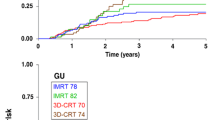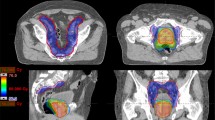Purpose:
To compare late rectal toxicity rates after three-dimensional conformal radiotherapy to the prostate alone (P-3D-CRT) and whole-pelvis intensity-modulated radiotherapy along with a prostate boost (WP-IMRT/PB) to the same nominal total dose to the prostate.
Patients and Methods:
68 patients treated with conformal radiotherapy to the prostate only to 76 Gy at the National Institute for Cancer Research, Genoa, Italy, represented the first group (P-3D-CRT). The second group consisted of 45 patients treated at the University of Texas Medical Branch (UTMB), Galveston, TX, USA, with IMRT covering the pelvic nodes and seminal vesicles to 54 Gy at 1.8 Gy per fraction and the prostate to 60 Gy in the same 30 fractions. A separate phase boosted the prostate to 76 Gy (WP-IMRT/PB). Major aspects of planning were remarkably similar at both institutions leaving the inclusion or not of pelvic nodes as the main treatment-related difference between the two groups. Late rectal toxicity was prospectively scored according to the RTOG scale. All patients have a 12-month minimum follow-up, and mean follow-up, similar in both groups, is 25.9 months (SD [standard deviation]: 8.4 months).
Results:
At 2 years, the estimated cumulative incidence of grade 2 late rectal toxicity is 6% ± 4% for WP-IMRT/PB and 21.2% ± 6% for P-3D-CRT (p = 0.06). The difference became significant (HR [hazard ratio] = 0.1, 95% CI [confidence interval]: 0.0–0.6; p = 0.01) at multivariate analysis. None of the patients developed grade 3+ toxicity.
Conclusion:
Despite the larger treated volume, WP-IMRT/PB allows more rectal sparing than P-3D-CRT.
Ziel:
Vergleich der rektalen Spättoxizität nach alleiniger dreidimensionaler konformaler Strahlentherapie der Prostata (P-3D-CRT) und nach intensitätsmodulierter Radiotherapie des gesamten Beckens mit Prostataradiochirurgie (WP-IMRT/PB) bei gleicher Gesamtdosis.
Patienten und Methodik:
Die erste Gruppe bestand aus 68 Patienten, die eine alleinige konformale Strahlentherapie der Prostata bis 76 Gy am National Institute for Cancer Research in Genua, Italien, erhielten (P-3D-CRT). Die zweite Gruppe umfasste 45 Patienten, welche am University of Texas Medical Branch (UTMB), Galveston, TX, USA, mit IMRT der Beckenlymphknoten und der Samenbläschen bis 54 Gy zu 1,8 Gy pro Fraktion und der Prostata bis 60 Gy, ebenfalls in 30 Fraktionen, behandelt wurden. Die Radiochirurgie der Prostata erfolgte separat bis 76 Gy (WP-IMRT/PB). Die Hauptaspekte bei der Planung waren an beiden Einrichtungen bemerkenswert ähnlich, so dass lediglich die Frage des Einschlusses der Beckenlymphknoten als Hauptunterschied bei der Behandlung der beiden Gruppen übrig blieb. Die rektale Spättoxizität wurde anhand der RTOG-Skala bewertet. Alle Patienten erhalten eine mindestens 12-monatige Nachsorge; die durchschnittliche Nachsorgedauer beträgt bei beiden Gruppen 25,9 Monate (SD [Standardabweichung]: 8,4 Monate).
Ergebnisse:
Nach 2 Jahren liegt die geschätzte kumulative Inzidenz der rektalen Spättoxizität Grad 2 bei 6% ± 4% für WP-IMRT/PB und 21,2% ± 6% für P-3D-CRT (p = 0,06). Der Unterschied wurde bei der Multivarianzanalyse signifikant (HR [Hazard-Ratio] = 0,1, 95%-CI [Konfidenzintervall]: 0,0–0,6; p = 0,01). Kein Patient entwickelte eine rektale Spättoxizität Grad 3+.
Schlussfolgerung:
Trotz des größeren Behandlungsumfangs ermöglicht die WP-IMRT/PB eine schonendere Behandlung des Rektalbereichs als die P-3D-CRT.
Similar content being viewed by others
Author information
Authors and Affiliations
Corresponding author
Rights and permissions
About this article
Cite this article
Sanguineti, G., Cavey, M.L., Endres, E.J. et al. Does Treatment of the Pelvic Nodes with IMRT Increase Late Rectal Toxicity over Conformal Prostate-Only Radiotherapy to 76 Gy?. Strahlenther Onkol 182, 543–549 (2006). https://doi.org/10.1007/s00066-006-1586-9
Received:
Revised:
Issue Date:
DOI: https://doi.org/10.1007/s00066-006-1586-9




